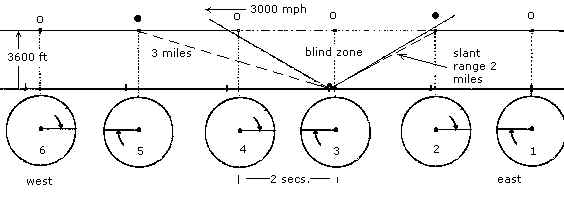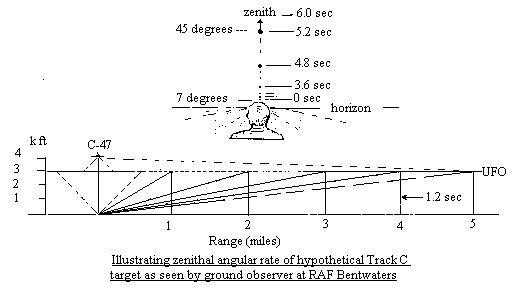
A Quantitative Radar-Visual Model of Track C
An Opinion by Martin Shough
Various possible explanations of the Bentwaters fast tracks are examined elsewhere. In the case of Track C at 2255Z the report of concurrent visual sightings makes these explanations especially strained. On general grounds it was argued that: 'The most natural and least contorted interpretation of this set of events appears to be in terms of a high-speed, radar-reflective luminous body overflying the field on a flat trajectory at an altitude of a few thousand feet.'
The consistency of this model can be roughly tested, since we have a number of fixed datum points: Four points on the track for the ranges of radar acquisition and loss; an operator estimate of target speed; a visual altitude bracketed by two observations from above and below; the known scan rate of the CPN-4; and the known approximate radiation pattern of the CPN-4.
Any radiation pattern can really only be defined operationally by a contour representing equiprobability of detection of a target of given cross-section, and even for the same antenna design this contour changes uniquely from site to site and from time to time due to varying topography and varying propagation conditions, among other factors. However some valid approximations are possible. The CPN-4 has a fairly typical cosecant2 vertical polar diagram, a nominal beamwidth at 3db-down points of 2.3° sweeping at 15(+/-1) rpm, the top edge cosecanted up to about 45°, and a maximum unambiguous range of 60 miles. The Technical Order cited by Klass offers operational performance minima for a small jet (T-33) in the low altitude cover indicating the effective radar horizon for such a target out to 35 nautical miles range, as tabulated below with equivalent target elevations:
Altitude (feet) |
Range minima, naut. miles [stat.miles] |
Elevation (degrees) |
2000 |
>20 [23] |
0.5 |
6000 |
>25 [28.75] |
2.1 |
10000 |
> 30 [34.5] |
3.6 |
25000 |
>35 [40.25] |
6.4 |
From these minimum ranges it can be seen that for a target with a cross-section comparable to a typical small jet fighter in level flight through the drum, track termini at ranges of about 30 statute miles imply an altitude of probably more than 2000' and probably no more than about 6000'. The visually estimated altitude from the Control Tower was about 4000' and the aircrew at about 4000' reported that the light passed below them, fixing its true altitude at perhaps 3-4000', which is therefore consistent with the range of values indicated by the radar track for a target comparable to a small jet.
From acquisition at 30 miles the target headed into the station at a mean estimated speed of 3000 mph then "disappeared on scope two miles east of station and immediately appeared on scope three miles west of station where it disappeared thirty miles west of station on scope." The asymmetry of this close-in signal loss and the slant ranges quoted are closely consistent with the overflight of a rapid target at low altitude, and in fact the altitude can be quite accurately derived from the scan rate of the antenna and some simple geometry.
A first approximation can be derived from the fact that for a target entering the radar shadow at a displayed slant range of 2 miles E, the 45° top edge of the beam fixes an upper altitude limit of about 7500' if the target is (improbably) last painted at the instant of arriving at the edge of the radiation pattern. When the antenna has rotated to the W two seconds later this 3000 mph target will be almost directly over the site and undetectable in the radar shadow; 2 seconds later the target is W of the site at a detectable elevation of about 35°, but the antenna is at this time on a reciprocal bearing looking E. When the antenna has again rotated through 180° and is again looking W a further 2 seconds later the target is observable for the first time since signal loss, now at a slant range of about 3.8 miles W of the site.
This model is quite close to the reported behaviour but can be refined further. In fact working back from the stated slant range of 3 miles W at reacquisition it turns out that only one altitude value will satisfy the conditions for a 3000 mph zenithal E-W target with the correct range asymmetry over 1½ antenna revolutions at 15 rpm: that value is approximately 3600', remarkably consistent with the bracketed altitude derived from visual observations and consistent also with the order of altitude implied by the ranges of the track termini for a target comparable to a small jet.

Schematic diagram of range asymmetry for CPN-4 plots of a zenithal 3000 mph target at 3600 feet altitude
It is interesting to consider the visible motion of an object satisfying this model as seen from the ground and the air. A representation of the changing brightness and angular rate of change in elevation can be derived as follows for a 3000 mph luminous source travelling through a ground observer's zenith at about 3000' altitude.
From an elevation of 7° over the E horizon at a range of 5 miles the source gains elevation to 11° in the first 2.4 seconds, increasing to 3 times its initial brightness at a range of 3 miles. About 2.8 seconds later, and now more than 40 times as bright as it initially appeared 5.2 seconds ago, it is at a ground distance of 3000', slant range 4000' at 45° elevation. In a further 0.7 seconds the light has crossed the zenith at maximum brilliance and begins dwindling westwards, dropping to an elevation 7° above the W horizon in 5.9 seconds. It has travelled from near-horizon to near-horizon in about 12 seconds with a maximum angular rate near the zenith of over 65°/second.

From an aircraft at 4000' the light (here modelled closing from approximately off the beam, at 3 o'clock or 9 o'clock) would appear at a slight depression angle of -2° at a range of 5 miles, losing elevation to -10° at one mile range after 4.8 seconds. During this time it would probably be visible from both crew seats through almost any part of the windshield. About 1 second later it is on the order of 100 times as bright as when first seen at 5 miles and at a depression angle of 45°, probably now being lost from the view of the crew, passing through the nadir and reappearing on the opposite beam less than 0.5 second later. The maximum angular rate is in the region of 90°/second.
With reported CAVU conditions and total periods of visibility in the region of perhaps a dozen seconds or so (obviously dependent on the absolute magnitude of the light and the range when first seen) there would appear to be time for observers to register more than a fleeting flash of light, but these are enormous angular rates, particularly at higher elevations, and would be well described by the phrases actually used:
. . . the tower reported seeing it go by and [it] just appeared to be a blurry light. A C-47 . . . reported seeing it also as a blurred light that passed under his aircraft - no report as to actual distance below the aircraft. [Perkins]
Tower personnel at Bentwaters reported to GCA a bright light passed over the field east to west at terrific speed and at about 4000 feet altitude. At same time pilot in aircraft at 4000 feet altitude over Bentwaters reported a bright light streaked under his aircraft travelling east to west at terrific speed. [BOI-485]
In summary there is good qualitative and quantitative agreement in the case of Track C between various radar-measured and visually estimated values. In particular the visually estimated altitude (physically bracketed by observers on the ground and in the air) is in close agreement with the small spread of values permitted by four consistent range datum points on the concurrent radar track. The range asymmetry of the track accurately models the CPN-4's performance with a real target of the speed reported. There is close agreement as to time, visually judged and radar displayed headings, and a broad consistency of radar-measured and visually estimated speeds.
This degree of cohesion invites one to be very sceptical about the hypothesis of chance, particularly given that the radar track and - to a lesser extent - the visual reports are individually resistant to conventional interpretation. The simplest hypothesis remains that of a self-luminous body with a radar cross-section on the order of 10m2 travelling at about Mach 4 on a flat trajectory at an altitude of about 3000'. However, such an object does not jibe with known aerospace developments in 1956 or with anything presently understood in the fields of atmospheric physics or meteoritics.